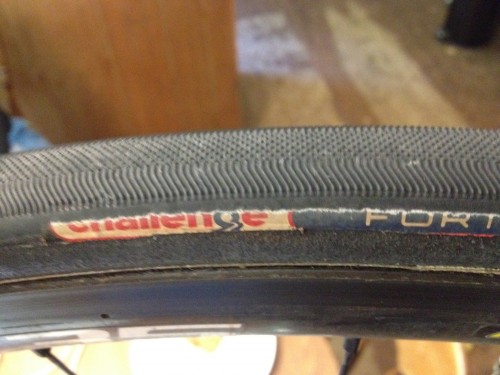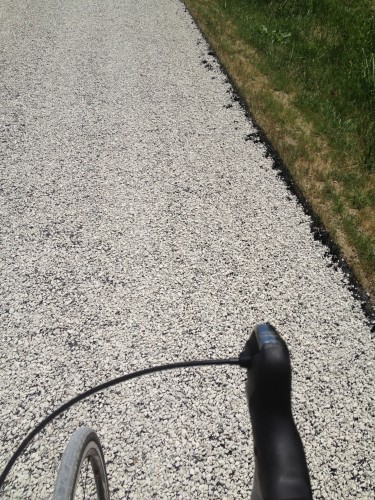Last weekend in Tulsa I rode some wider tires, 24mm, than I usually ride. They were Challenge tires and I normally race on Vittoria tubulars. I knew I wasn’t in the right form to have tires be my limiting factor, so I thought it was a good time to test them out at race speed.
It might not have been the best time because I was dealing with so many other issues, I didn’t really get a chance to put them through a true test. I don’t have anything here to report other than they worked. I’m going to ride them next weekend in Tour of Kansas City and am going to take them out to California this weekend and do some descending on them I’ve historically done on clinchers.
That being said, I know a lot has been done recently about tire width and pressure. I saw this article that some guys had done some controlled rollouts of lots of different tires with different pressures. I’m not sure how scientific the procedure was, but the results were important.
They found that the “fastest” tires had half the resistance as the slowest. In real-life terms during a ten-kilometer time trial, the slowest tire (Continental Grand Prix 3000) would take 34 seconds longer than the fastest (a hand-made clincher with a cotton casing).
That isn’t a small thing. Half the rolling resistance is a lot. They found that the wider the tire, the lower rolling resistance. I think I could agree with that from personal experience. I’m not sure how many tubular tires they tested. Mounting and dismounting so many sewup tires wouldn’t be an easy thing. The tires would have to be glued onto the rims to make the test accurate.
Anyway, I have a lot of different pressures I ride under different conditions. There are lots of things to consider. Mainly, the tires you’re riding, the course and the day/weather. I usually race right around 100 psi in my tubular tires in a criterium. I might ride a little more in a road race if the road is in good condition. But, like I said, the tires you’re riding make a huge difference. Vittoria tubulars are way more supple than continentals, so the same pressure feels a lot difference.
When the roads are bumpy or chip and seal, I ride way less pressure. I train on less than 80 psi always and don’t pump up my tires until it is under 50. I know that sounds really low, but the ride is much better.
In a criterium, you’re trying to have the right pressure for the best cornering abilities. In a road race, you usually are mainly concerned with the least amount of rolling resistance. Sometimes the cornering abilities of the tires, in road races, can be more important than the rolling resistance. Races with a lot of corners or difficult descents come to mind.
Anyway, after reading the Bicycle Quarterly post, I’m going to be paying way more attention to all of this. In cross and on the MTB, it is super crucial, but I’d sort of neglected the road. With all the new tire and wheel options, this might be complicated.







If there is one constant in bicycling subculture it’s that what is old is new again and how fashion-sensitive the expensive-end of the sport is.
Mountain bike racing went from fat+no suspension to skinny+ full suspension and settled on fat+some suspension.
I believe the efficiency of tires topic has been covered in auto racing research previously. I don’t have it handy, but I’ve heard as much before.
They say in Forumla 1 that, the overall result is decided by equally important parts: 1) the ability of the driver, 2) the engine, 3) the chassis and 4) the tires.
In cycling the percentages would be different, but the tire/wheel combo is WAY more important than the frame and shifter system. And an important part of that again is to run the right amount of pressure.
Have you guys tried Tufo road tires? It was quit interesting to run them at 180psi:)
What tire pressure are you using in a crit?
I think I need to use lower tire pressure.
What tire pressure are you using in criterium? Would you go as low if you were on a clincher? Would you go lower if you weight was 125 lbs?
http://www.cyclingnews.com/features/tech-feature-the-work-of-wheel-energy
Obviously pressure is a personal preference to a degree. The chart in the link below is a nice starting point.
http://www.bikequarterly.com/images/TireDrop.pdf
I race on “old school” tubular wheels, so I’m not sure how wide of a tire I can glue on.Comps and Vittorias work well enough for me, so why change.
You mention that Vittoria tubulars are way more supple than continentals. I’m sure that you remember that the CX’s from 20 years ago were way more supple than the Vittorias you can get today
Steve,
Is all of your road training done on tubulars? Do you use any type of sealant?
When I lived and raced in Belgium during the ’80s the Belgian Family I lived with aways bought their son’s race bikes from Van de Veegaete sport. The owner was the mechanic for the Belgian national team. He told us to run 7atm for dry conditions and 6.5 atm for rain and or cobblestone courses. That was with GP4 32 holes with vittoria cx tubulars. Seemed to work just fine.
And don’t forget the increased puncture resistance.
Great post. Does anyone know if wider/lower pressures generally apply across the board to clinchers? I did see the Bicycle Quarterly tested clinchers as well, but I don’t think there was comment about this. Thanks.